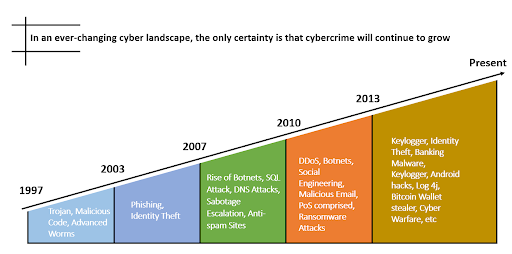Can it happen to us? Are we ready to combat a cyberattack? All over the world, security officers have been fielding these questions from CEOs and the Board of Directors in the wake of large, high-profile cyberattacks.
Yes, is the honest answer when attackers have continuously expanded their capabilities and taken advantage of limited cybersecurity awareness among businesses.
“Attackers are growing more and more sophisticated. We see an increasing trend towards trickle-down of advanced attack techniques, from Apex Predator groups to nation-state attackers moving into more and more tools and techniques that are available for a broader range of cybercriminal and ransomware groups,” said Rob Lefferts, Corporate Vice President, M365 Security.
In 2021, Cybercriminals targeted critical infrastructure, including information technology, financial services, healthcare, and energy sectors, with headline-grabbing incidents which harmed businesses.
The more sophisticated, relentless, and widespread cybercrime drives the need for a next-gen Web Application Firewall to identify and defend against emerging exploits.
Cybercrimes: Rising and Sophisticated
More than $6.9 billion was lost to cybercrime in 2021, surpassing losses reported in 2020 by about $2billion – according to the 2021 Internet Crime Report by the FBI.
In the last two decades, from cybercrime on individuals and organizations, the sophistication of attacks has come a long way.
“The core cybercrime method, which is phishing, hasn’t changed, but the sophistication of them has,” – Chris Jenkins, Chief Digital Officer of FBI, said. He explained – “The ability of cybercriminals to create more real-looking, more compelling fake sites for people to log into has gone up significantly.”
The hackers have become smart and can commit an attack sitting in any country. With multiple attack vectors, they sabotage or bypass the victim’s security strengths while targeting their weaknesses. In these kinds of attacks, the cybercriminals have unfair benefits and can be unnoticed for a long time, even impossible to detect. Moreover, it is not one attacker who is launching the hit. Instead, it is a group of them targeting an infrastructure through multiple entry points.
But that is only half the picture. Cybercrimes are automated, and the target is unknown vulnerabilities that organizations left unfixed. Everything that aids the attacker needs to launch an attack is readily available on the dark forum.
The latest Global Threat Insights Report highlighted the widespread availability of hacking tools in cyberspace –the number of hacking tools increased by 65% from 2020 to 2021.
For instance, some of the recent large-scale DDoS attacks involved Mris, a new powerful botnet, which can generate a massive volume of requests per second. The most common DDoS attacks remained volumetric – taking advantage of publicly available tools to freeze the targeted network.
Next-Gen WAF: Securing Your Business at the Edge
What makes businesses more vulnerable to cybercrime? The truth is they are using the traditional security solutions, which still employ the same defensive strategies they compassed before the threat landscape evolved. The sophisticated cyber-attacks can easily sneak past traditional solutions, including WAF.
The organization requires a comprehensive, holistic security approach to withstand emerging threats. It means you should have complete visibility and the capability to detect unknown threats to change them into known threats. You should seriously consider Next-gen WAF that leverages ML (Machine Learning) and Threat Intelligence to identify and prevent emerging threats.
The next-gen WAF goes beyond the traditional prevention system and inspects all malicious traffic regardless of encryption, protocol, or port. Then it blocks malware, spyware, exploits, and other known & unknown vulnerabilities.
One such solution is AppTrana WAF, a fully managed risk-based solution that uses threat intelligence to perform high-performance analysis of all web traffic to detect and block zero-day exploits. It includes several key valued benefits like multi-layered protection, end-point security, and ransomware & DDoS protection.
The key features of the next-gen firewall to ensure comprehensive protection against the modern IT risks include:
- Ensures zero false positives with accurate behavior monitoring
- Automatic protection against known threats (including OWASP Top 10)
- Comprehensive Threat Protection, which comprises malware protection, anti-virus, IDS/IPS
- Automated Scanning to ensure complete coverage
- Bot Attack Prevention
- Advanced API Protection
- Unmetered DDoS Protection for Layer 3-7
The Closure
The techniques for cybercrime are getting more sophisticated; hence it is more crucial than ever to have a next-gen WAF.
When the threat landscape evolves continuously, organizations that produce credible responses will have a competitive advantage over those that are slow. This will translate into substantial business value. By adopting a broad-based holistic cybersecurity approach, businesses will be better able to respond immediately and understand the nature of increasing threats.











